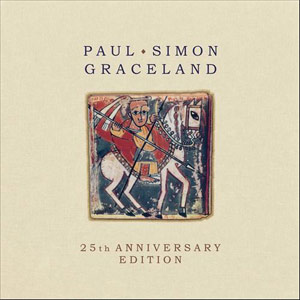
Graceland: 25th Anniversary
Legacy
“I have reason to believe we all will be received in Graceland.” A tentative, but clear assertion for the injection of African and world music into the MTV generation’s psyche. About a year after Live Aid, in the gathering flurry of AIDS, underneath a cloud of Reagan-induced punk and Dionysian hairspray-tainted metal, Paul Simon travelled to apartheid-torn South Africa to record an album with musicians in a land that could barely be shrugged at by pop music consumers. This was well after Peter Gabriel’s “Biko,” a brooding, dark, and all too real-life protest song about the eponymous apartheid activist. In contrast to the sinister feel of the Gabriel ode, Simon’s composition would be undoubtedly happy, sunny, and fancy-free.
However, underneath all those joyful jams, Simon managed to slip in plenty of metaphor and social critique. The leadoff track, “Boy in the Bubble,” starts with a folky accordion riff and leads innocently to a rousing jig. There’s plenty of room for lyrics about a cute girl with a ribbon in her hair or something, but instead Simon croons a picture of a bomb blast in an urban war zone, meaning you could easily miss because you were too busy dancing. The commentary doesn’t end there; the title track’s journey to Elvis’ home is fraught with memories of a broken marriage and populated by the gorgeous dregs of the American dream. “You Can Call Me Al,” contrary to the comedic video (the bass isn’t played by Chevy Chase, it’s Bakithi Kumalo), depicts people looking back on their lives, wondering why they didn’t get the attention they needed desperately, with the aging “foreign man” afraid to end up in a “cartoon graveyard.” Simon is known for more than pop music—just look at his pre-solo catalog with Art Garfunkel—but this was the song that landed him on MTV, in khakis and deck shoes.
And then you get to “Homeless,” the song that made Ladysmith Black Mambazo a household name (at least in my household), the song that brought a thousand voices into harmonies we had no idea could exist. We also had no idea what they were singing, but the soul of the song was obvious. It was obvious that it was something that we would only ever have experienced because Paul Simon defied the artistic boycott of South Africa to bring this music to the world. He wasn’t exploiting them like old blues men, he was giving them a lift up to the white-dominated world of popular music. There was no looking back for Ladysmith Black Mambazo; it seems like they were all over late-night television for the whole of the ’80s.
As for the extra songs in this deluxe reissue, do we really need them? Graceland is a solid record, but it’s nice to hear how the songs worked their way into existence. So, yes, it is worthwhile having a demo version of “You Can Call Me Al” and an alternate take of “Diamonds on the Soles of Her Shoes.” Plus, there’s plenty of song explanation on the accompanying DVD. The rehearsal footage makes it absolutely clear, if it wasn’t from the actual album, that bassist Bakithi Kumalo was the glue that held the band together. He translates to the non-English speakers for Paul Simon; he nods to the other players for changes; he keeps his head moving to anchor the beat; and he sure knows how to pull off a three-finger slide on the bass. As a whole package, the 25th Anniversary edition of Graceland is thorough and tasteful, and thankfully avoids the masturbatory weakness of the majority of reissues. Graceland can stand on its own, but maybe the youngsters who think that Vampire Weekend came up with this sound will now get a chance to hear the truth.
Michael P. O’Shaughnessy
PAST PERFECTS
Eccentric Soul: A Red Black Green Production
David Kilgour, Here Come the Cars
We've Got a Fuzzbox and We're Gonna Use It
Medicine, Shot Forth Self Living and The Buried Life
Opeth, Blackwater Park, Deliverance, Damnation, Lamentations: Live at Shepard Bush Empire 2003
The Trypes, Music for Neighbors
Noh Mercy
fIREHOSE, Lowflows: The Columbia Anthology ('91-'93)
Doug Jerebine, Is Jesse Harper
Poison Idea, Darby Crash Rides Again: The Early Years
Feedtime, The Aberrant Years
Roach Motel, It's Lonely at the Top
Tronics, Love Backed By Force
Archers of Loaf, Vee Vee
